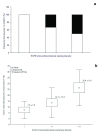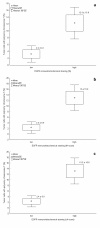EGFR protein overexpression correlates with chromosome 7 polysomy and poor prognostic parameters in clear cell renal cell carcinoma
- PMID: 22475688
- PMCID: PMC3368721
- DOI: 10.1186/1423-0127-19-40
EGFR protein overexpression correlates with chromosome 7 polysomy and poor prognostic parameters in clear cell renal cell carcinoma
Abstract
Background: The role of epidermal growth factor (EGF) and its receptor (EGFR) in the pathogenesis and progression of various malignant tumors has long been known, but there is still disagreement concerning prognostic significance of EGFR expression in clear cell renal cell carcinoma (CCRCC). The present study was designed to analyze more objectively the protein EGFR expression in CCRCC and to compare its value with EGFR gene copy number changes and clinicopathologic characteristics including patient survival.
Methods: The protein EGFR expression was analyzed immunohistochemically on 94 CCRCC, and gene copy number alterations of EGFR by FISH analysis on 41 CCRCC selected according to distinct membrane EGFR staining.
Results: Membrane EGFR expression in tumor cells was heterogeneous with respect to the proportion of positive cells and staining intensity. FISH analysis did not reveal EGFR gene amplification, while polysomy of chromosome 7 found in 41% was associated with higher EGFR membrane expression. Moreover, EGFR overexpression was associated with a higher nuclear grade, larger tumor size and shorter patient's survival, while there was no connection with pathological stage.
Conclusion: In conclusion, the protein expression of EGFR had an impact on prognosis in patients with CCRCC, while an increased copy number of chromosome 7 could be the possible reason for EGFR protein overexpression in the absence of gene amplification.
Figures




Similar articles
-
Proliferating cell nuclear antigen and epidermal growth factor receptor (EGFr) status in renal cell carcinoma patients with polysomy of chromosome 7.Cancer Genet Cytogenet. 2001 Mar;125(2):139-46. doi: 10.1016/s0165-4608(00)00375-7. Cancer Genet Cytogenet. 2001. PMID: 11369057
-
Prognostic significance of immunohistochemical staining for myoferlin in clear cell renal cell carcinoma and its association with epidermal growth factor receptor expression.Urol Oncol. 2019 Nov;37(11):812.e9-812.e16. doi: 10.1016/j.urolonc.2019.07.002. Epub 2019 Aug 14. Urol Oncol. 2019. PMID: 31421995
-
Epidermal growth factor receptor overexpression/amplification in adenocarcinomas arising in the gastrointestinal tract.Rev Esp Enferm Dig. 2011 Dec;103(12):632-9. doi: 10.4321/s1130-01082011001200005. Rev Esp Enferm Dig. 2011. PMID: 22217347 English, Spanish.
-
Prognostic Impact of Membranous/Nuclear Epidermal Growth Factor Receptor Localization in Clear Cell Renal Cell Carcinoma.Int J Mol Sci. 2021 Aug 14;22(16):8747. doi: 10.3390/ijms22168747. Int J Mol Sci. 2021. PMID: 34445451 Free PMC article.
-
High expression of KCa3.1 in patients with clear cell renal carcinoma predicts high metastatic risk and poor survival.PLoS One. 2015 Apr 7;10(4):e0122992. doi: 10.1371/journal.pone.0122992. eCollection 2015. PLoS One. 2015. PMID: 25848765 Free PMC article.
Cited by
-
Clinical Applications of Aneuploidies in Evolution of NSCLC Patients: Current Status and Application Prospect.Onco Targets Ther. 2022 Nov 10;15:1355-1368. doi: 10.2147/OTT.S380016. eCollection 2022. Onco Targets Ther. 2022. PMID: 36388157 Free PMC article. Review.
-
Rethink of EGFR in Cancer With Its Kinase Independent Function on Board.Front Oncol. 2019 Aug 23;9:800. doi: 10.3389/fonc.2019.00800. eCollection 2019. Front Oncol. 2019. PMID: 31508364 Free PMC article.
-
RIN1 promotes renal cell carcinoma malignancy by activating EGFR signaling through Rab25.Cancer Sci. 2017 Aug;108(8):1620-1627. doi: 10.1111/cas.13297. Epub 2017 Jul 3. Cancer Sci. 2017. PMID: 28612496 Free PMC article.
-
Evaluation of EGFR, KRAS and BRAF gene mutations in renal cell carcinoma.J Kidney Cancer VHL. 2014 Aug 5;1(4):40-45. doi: 10.15586/jkcvhl.2014.10. eCollection 2014. J Kidney Cancer VHL. 2014. PMID: 28326248 Free PMC article.
-
Analysis of Chromosome 3, 7 and 8 Centromeric Regions in Bronchial Lavage Specimens by FISH.Turk Thorac J. 2016 Oct;17(4):141-147. doi: 10.5152/TurkThoracJ.2016.001. Epub 2016 Oct 1. Turk Thorac J. 2016. PMID: 29404144 Free PMC article.
References
-
- Baselga J. EGFR as a target for anticancer therapy-focus on cetuximab. Eur J Cancer. 2001;37:S16–S22. - PubMed
Publication types
MeSH terms
Substances
LinkOut - more resources
Full Text Sources
Medical
Research Materials
Miscellaneous

